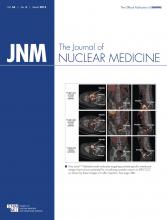Clinical translation of diagnostic drugs: Josephson and Rudin provide an overview of optimal approaches to address the challenges of cost and time in development of radioactive imaging agents, particularly for small target populations.
PET/CT and endocrine resistance: Cheng and colleagues explore the question of whether 18F-FMISO PET/CT can predict primary resistance to hormonal therapy in estrogen receptor–positive breast cancer.
Sequential PET in breast cancer: Hatt and colleagues determine the best image-derived parameters extracted from sequential 18F-FDG PET scans for early tumor response prediction after 2 cycles of neoadjuvant chemotherapy in breast cancer.
PET imaging of σ-receptors: Dehdashti and colleagues evaluate the safety and dosimetry of a novel cellular proliferative marker and, in a first-in-human study, assess the feasibility of its use in PET imaging of tumor proliferation in newly diagnosed malignant neoplasms.
Delayed PET in alveolar echinococcosis: Caoduro and colleagues investigate the usefulness of delayed 18F-FDG PET imaging in the management of patients with this rare and chronic parasitic disease.

68Ga-DOTANOC vs. 68Ga-DOTATATE PET/CT: Wild and colleagues compare both somatostatin receptor imaging approaches in a single group of patients with gastroenteropancreatic neuroendocrine tumors.
Ultra low dose cardiac SPECT: Nakazato and colleagues assess the feasibility of very low dose myocardial perfusion imaging by exploring the minimal count level in the myocardium required for accurate results.
PSMA-binding small molecules: Barrett and colleagues report on the pharmacokinetics of novel 123I-labeled small molecules targeting prostate-specific membrane antigen and on their ability to visualize prostate cancer in human bone, soft tissue, and the prostate gland.
PET and mGluR5: Wong and colleagues present the results of a first-in-human study assessing the safety and effectiveness of 18F-FPEB, a novel PET radiopharmaceutical for quantifying regional brain concentrations of metabotropic glutamate receptor type 5.

Initial clinical study with 124I-F16SIP: Heuveling and colleagues describe the results of a microdosing phase 0 clinical study of pharmacokinetics, biodistribution, and specific tumor targeting with this radiolabeled antitenascin-C mini antibody.
Cardiac PET/MR: Rischpler et al. offer a comparative summary of existing applications of PET and MR in cardiology and suggest potential cardiac applications using the unique properties of the hybrid instrumentation.

EGFR-directed RIT: Saker and colleagues analyze the efficacy of 90Y-labeled cetuximab radioimmunotherapy in head and neck squamous cell carcinoma cell lines and look at the most desirable DNA effects in epidermal growth factor receptor–targeted therapy.
PET and BRAF therapy response: McKinley and colleagues explore the utility of 18F-FLT PET in noninvasive quantification of changes in tumor proliferation associated with pharmacologic inhibition of downstream effectors of the most frequently mutated protein kinase in human cancer.

Methionine uptake in acute MI: Taki and colleagues research serial changes in and mechanisms of 14C-methionine uptake in a rat model of myocardial ischemia and reperfusion and discuss implications for imaging of inflammation early after myocardial infarction.
Verapamil transport across BBB and BPB: Ke and colleagues use compartmental modeling to analyze dynamic biodistribution data on transport of the P-glycoprotein PET ligand 11C-verapamil across the blood–brain and blood–placenta barriers.
18F-FDG–labeled MSCs and MAPCs: Wolfs and colleagues detail an optimized approach to radiolabeling of mesenchymal stem cells and multipotent adult progenitor cells in vitro and investigate potential radiotoxic effects.
KOR antagonist and PET: Zheng and colleagues synthesize 11C-LY2795050, a selective κ-opioid receptor antagonist, and evaluate its potential as a PET tracer for imaging receptor involvement in neuropsychiatric and addictive disorders.
MR-based PET motion correction: Würslin and colleagues report on phantom and patient studies of the applicability and performance of an MR-based method of respiratory motion correction for PET tumor imaging.
USP monographs and PET drugs: Schwarz and colleagues describe the history of USP monographs and PET drug standards, the effects of potential changes, and new SNMMI recommendations for the future.
Appropriate use criteria for amyloid PET: Johnson and members of the Alzheimer’s Association and SNMMI Amyloid Imaging Taskforce provide a consensus expert opinion on both appropriate and inappropriate uses for PET imaging of brain amyloid-β.
ON THE COVER

Two novel 123I-labeled small molecules targeting prostate-specific membrane antigen have shown potential for visualizing prostate cancer on SPECT/CT, as shown by these images 4 h after injection. See page 380.
- © 2013 by the Society of Nuclear Medicine and Molecular Imaging, Inc.







